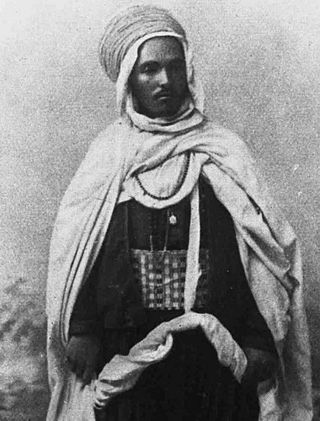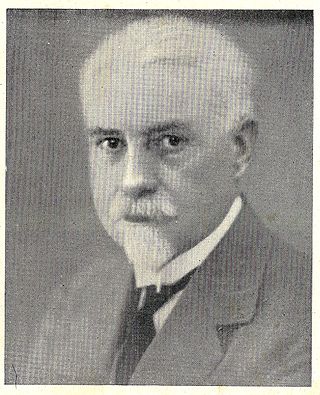
MoulayYusef ben Hassan, born in Meknes on 1882 and died in Fes on 1927, was the Alaouite sultan of Morocco from 1912 to 1927. He was the son of Hassan ben Mohammed.

The French protectorate in Morocco, also known as French Morocco, was the period of French colonial rule in Morocco between 1912 and 1956. The protectorate was officially established 30 March 1912, when Sultan Abd al-Hafid signed the Treaty of Fez, though the French military occupation of Morocco had begun with the invasion of Oujda and the bombardment of Casablanca in 1907.
Abdelkebir Khatibi was a prolific Moroccan literary critic, novelist, philosopher, playwright, poet, and sociologist. Affected in his late twenties by the rebellious spirit of 1960s counterculture, he challenged in his writings the social and political norms upon which the countries of the Maghreb region were constructed. His collection of essays Maghreb pluriel is one of his most notable works.
Arsène Roux was a French Arabist and Berberologist. He was born in Rochegude and emigrated to Morocco in his early twenties where he started studying Classical Arabic, Moroccan Arabic and the Moroccan Berber languages. In the following years, he worked in various schools and universities as a professor and director; he also founded and presided over the Collège Berbère d'Azrou.

Edmond Amran El Maleh was a Moroccan Jewish writer of Berber extraction.
The document known as the Berber Dahir is a dhahir (decree) created by the French protectorate in Morocco on May 16, 1930. This Dahir changed the legal system in parts of Morocco where Amazigh languages were primarily spoken, while the legal system in the rest of the country remained the way it had been before the French invasion. Sultan Muhammad V signed the Dahir under no duress, though he was only 20 years old at the time.

The history of the city of Casablanca in Morocco has been one of many political and cultural changes. At different times it has been governed by Berber, Roman, Arab, Portuguese, Spanish, French, British, and Moroccan regimes. It has had an important position in the region as a port city, making it valuable to a series of conquerors during its early history.
Michel Vieuchange, born in Nevers in 1904 and died in Agadir in 1930, was a French adventurer who was the first European to visit the abandoned ruins of the walled city of Smara, in the interior of the Sahara.

Jilali ben Driss al-Youssefi al-Zerhouni, commonly known as El Rogui, El Roghi or Bou Hmara, was a pretender to the throne of Morocco in the period 1902–1909, during the reign of Abdelaziz and Abd al-Hafid.

The French conquest of Morocco began in 1907 and continued until 1934. By the Treaty of Fez of 1912, France imposed a protectorate over Morocco and spent the next two decades taking control of the country.

Paul-Jean-Louis Azan was a French general and author. He is remembered for his missions to the United States during World War I and his French historical and military writings which examined and celebrated French Colonial rule in North Africa.
Amal El Alami is a Moroccan physician, neurosurgeon and writer. He was born at Casablanca, the quartier Habous, in a nationalist family linked to the Istiqlal Party.
General Henri Joseph Simon was a French army officer. He is particularly associated with the French protectorate of Morocco where he spent much of his army career. Simon served as head of intelligence to Hubert Lyautey and as director of the Moroccan Indigenous Affairs Service as well as conventional combat roles. He later wrote books about his time in Morocco and helped the production of the 1934 film Itto.
Abdelhak Serhane is a Moroccan novelist writing in French. Serhane grew up in the Middle Atlas region of Morocco, in the village Azrou.
The following is a timeline of the history of the city of Fez, Morocco.

The Zawiya Dila'iya or Zawiyaof Dila was a Sufi brotherhood, centred in the Middle Atlas range of Morocco.

The Chaouia is a historical and ethno-geographical region of Morocco. It is bounded by the Oum er-Rbi' River to its southwest, the Cherrate River to its northeast, the plain of Tadla to the southeast and the Atlantic Ocean to the northwest. The region covers a land area of nearly 14 000 km2. The term also refers to a tribal confederation that traditionally inhabits the region.
Kasbah Tamdert is a fortress and kasbah in Fes, Morocco. It is located near Bab Ftouh in southern Fes el-Bali.

Frédéric Weisgerber was a French colonial doctor and cartographer active in Morocco before and during the French Protectorate. In 1904, he wrote a book entitled Trois mois de campagne au Maroc: étude géographique de la région parcourue about his three-month participation in a campaign in Morocco in the winter of 1898.
Henri Terrasse was a French historian, archeologist, and orientalist who specialized in the art and history of the Islamic world and of Morocco in particular.










